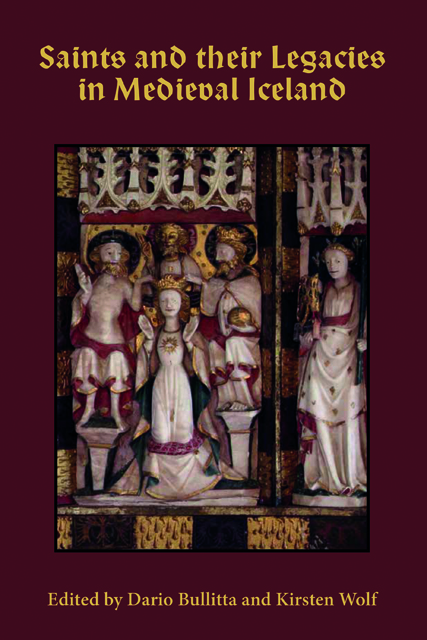Book contents
- Frontmatter
- Contents
- List of Illustrations
- List of Contributors
- Acknowledgments
- List of Abbreviations
- Introduction: The Splendor of the Saints
- Rannsǫkun Heilagra Bóka: The Search for Holy Books
- Heilagir Byskupar: Holy Bishops
- Heilagir Karlar ok Englar: Holy Men and Angels
- Heilagar Meyjar: Holy Maidens
- Bibliography
- Index of Manuscripts
- General Index
- Studies in Old Norse Literature
8 - Þat vóro lavg munka: A Reading of Benedikts saga in Light of the Regula sancti Benedicti
Published online by Cambridge University Press: 14 January 2023
- Frontmatter
- Contents
- List of Illustrations
- List of Contributors
- Acknowledgments
- List of Abbreviations
- Introduction: The Splendor of the Saints
- Rannsǫkun Heilagra Bóka: The Search for Holy Books
- Heilagir Byskupar: Holy Bishops
- Heilagir Karlar ok Englar: Holy Men and Angels
- Heilagar Meyjar: Holy Maidens
- Bibliography
- Index of Manuscripts
- General Index
- Studies in Old Norse Literature
Summary
In addition to providing general evidence for the existence of a cult of St Benedict in medieval Iceland, this essay discusses the textual relations between Benedikts saga – the most complete Old Norse-Icelandic version of the widely circulated Vita beati Benedicti abbatis (BHL 1102), which forms part of Gregory the Great’s Dialogi – and the Regula sancti Benedicti, a collection of precepts for the governance of Benedictine monasteries. In the following, I consider the personal growth of St Benedict according to the legend and analyze individual episodes that are closely connected to specific precepts contained in the Regula. Subsequently, I focus on a small but noteworthy textual interpolation in Benedikts saga and discuss a significant omission, both of which appear to be deliberate editorial interventions on the part of the Norse compiler.
The cult of St Benedict in medieval Iceland
Benedikts saga is the only Old Norse-Icelandic text devoted entirely to the life of St Benedict of Nursia (traditionally AD 480–547, more likely c. AD 490/500–560). There is scant information about the cult of St Benedict in medieval Iceland, though Margaret Cormack provides some evidence in her surveys of the veneration of saints in Iceland. The earliest is a record of St Benedict’s Holy Day of Obligation in the religious calendar in Grágás on March 21, which is traditionally considered his dies natalis. This was later abolished by the 1275 Kristinn réttr Árna byskups (hinn nýi), the Code of Ecclesiastical Law by Árni Þorláksson (1237–1298), which applied only to the Skálholt diocese, however. In addition, all the calendars examined by Cormack mention his translatio on July 11.
Secondly, the máldagar (‘church inventories’) testify that the cult of St Benedict was associated with the monasteries founded during the twelfth and thirteenth centuries, which were mostly Benedictine houses. The first two monasteries were in the Hólar diocese: the monastery of Þingeyrar (Húnafjörður), the construction of which was promoted by Bishop Jón Ǫgmundarson (1052–1121) and which began its activities in 1133, and the monastery of Munkaþverá (Eyjafjörður), founded in 1155. About a decade later (1166), a Benedictine monastery was also built in the Skálholt diocese, in Hítardalur (Borgarbyggð), but it remained active only until 1202.
- Type
- Chapter
- Information
- Saints and their Legacies in Medieval Iceland , pp. 197 - 228Publisher: Boydell & BrewerPrint publication year: 2021



